
HMS Liverpool was a 28-gun Coventry-class sixth-rate frigate of the Royal Navy. Launched in 1758, she saw active service in the Seven Years' War and the American Revolutionary War. She was wrecked in Jamaica Bay, near New York, in 1778.

HMS Amazon, was a 36-gun Amazon-class frigate, built at Rotherhithe in 1795 to a design by Sir William Rule. Carrying a main battery of 18-pounder long guns, she was the first of a class of four frigates. She had a short but eventful career during the French Revolutionary War, which she spent in the Channel and Western Approaches, part of a frigate squadron under Sir Edward Pellew. She was wrecked in Audierne Bay in 1797, following an action on 13 January with the French ship-of-the-line, Droits de l'Homme.

HMS Latona was a 36-gun, fifth-rate frigate of the Royal Navy that served during the American Revolutionary War, the French Revolutionary Wars, and the Napoleonic Wars. Shortly after her launch in 1781, she participated in the Battle of Dogger Bank against a Dutch squadron in the North Sea. In September 1782, Latona took part in the relief of Gibraltar and was the first ship in the convoy to pass through the Straits, when Richard Howe sent her ahead, to spy on the condition of the Franco-Spanish fleet in Algeciras Bay.

HMS Lizard was a 28-gun Coventry-class sixth-rate frigate of the Royal Navy, in service from 1757 to 1828. Named after the Lizard, a peninsula in southern Cornwall, she was a broad-beamed and sturdy vessel designed for lengthy periods at sea. Her crewing complement was 200 and, when fully equipped, she was armed with 24 nine-pounder cannons, supported by four three-pounders and twelve 1⁄2-pounder swivel guns. Despite her sturdy build, she was plagued with maintenance problems and had to be repeatedly removed from service for repair.

HMS Triton was a modified Mermaid-class sixth-rate 28-gun frigate of the Royal Navy. She was ordered on 25 December during the Falklands Crisis of 1770, a conflict that was resolved the following January, before work on her had begun. Launched in October 1773, she first served in the American Revolutionary War in operations against the rebels on the St Lawrence River. In 1780, she sailed with Rear admiral George Rodney's fleet for the Relief of Gibraltar and on 8 January, assisted in an attack on a Caracas Convoy off the coast of Spain, capturing several Spanish merchant ships. Later that month she played a role at the Battle of Cape St Vincent. During the French Revolutionary Wars Triton served on the Jamaica Station and was present at the Battle of the Saintes on 12 April 1782. She finally paid off in November 1795 and was broken up at Deptford Dockyard in January 1796.

HMS Brilliant was a 36-gun Venus-class fifth-rate frigate of the British Royal Navy that saw active service during the Seven Years' War with France. She performed well against the French Navy in the 1760 Battle of Bishops Court and the 1761 Battle of Cape Finisterre, but was less capable when deployed for bombardment duty off enemy ports. She also captured eight French privateers and sank two more during her six years at sea. The Royal Navy decommissioned Brilliant in 1763. The Navy sold her in 1776 and she became an East Indiaman for the British East India Company (EIC). Brilliant was wrecked in August 1782 on the Comoro Islands while transporting troops to India.

HMS Actaeon was a 28-gun Coventry-class sixth-rate frigate of the Royal Navy. Her crewing complement was 200 and, when fully equipped, she was armed with 24 nine-pounder cannons, supported by four three-pounders and twelve 1⁄2-pounder swivel guns.

HMS Aigle was a 36-gun, fifth-rate frigate of the Royal Navy. Ordered on 15 September 1799 and built at Bucklers Hard shipyard, she was launched 23 September 1801. More than fifty of her crew were involved in the Easton Massacre when she visited Portland in April 1803 to press recruits. Her captain and three other officers stood trial for murder but were acquitted. Much of Aigle's career as a frigate was spent trying to keep the English Channel free of enemy warships and merchant vessels. On 22 March 1808, she was first into the action against two large French frigates, compelling one to seek the shelter of the Île de Groix batteries and forcing the other onto the shore.
HMS Stag was a 32-gun fifth-rate frigate built for the Royal Navy. She was ordered in 1790 and work began in March 1792 at Chatham Docks. Completed in August 1794, Stag spent much of her service in home waters, where she worked to protect British shipping from French privateers. In an action on 22 August 1795, Stag engaged, and forced the surrender of, the Dutch frigate Alliante, and took part in the chase that ended with the capture of Bonne Citoyenne by HMS Phaeton on 10 March 1796.

HMS Sylph was a 16-gun Albatross-class brig-sloop of the Royal Navy designed by William Rule and launched in 1795 at Deptford Dockyard. Her namesake was the air spirit sylph. She commissioned in August 1795 under Commander John Chambers White, who would have her until the end of 1799. She was later commanded by Charles Dashwood.
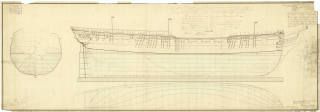
HMS Artois was a fifth-rate Artois-class frigate of the Royal Navy, designed by Sir John Henslow and launched in 1794 at Rotherhithe as the lead ship of her class. She served for the majority of her career in the English Channel under the command of Edmund Nagle in the squadrons of Edward Pellew and John Borlase Warren, notably taking part in the action of 21 October 1794 where she captured the 44-gun frigate La Révolutionnaire almost singlehandedly. She participated in a number of other actions and events including the attempted invasion of France in 1795. Artois continued to serve actively on the coast of France in blockade and patrolling roles, taking a large number of ships as prizes, until she was wrecked with no loss of life off Île de Ré on 31 July 1797 while attempting to reconnoitre the harbour of La Rochelle.
The Maidstone-class frigate was a 32-gun fifth-rate frigate class of two ships designed by Sir John Henslow and ordered on 4 February 1795. The class was a close copy of Henslow's earlier Alcmene class, but was constructed of pitch pine instead of oak. With concerns over whether the lighter building material would safely hold an armament of 18-pounder long guns, the class was instead armed with smaller 12-pounders. Both ships of the class served through the French Revolutionary Wars, but neither had a long career. Shannon was sold at Sheerness Dockyard in May 1802 and Maidstone was placed in ordinary at Chatham Dockyard in 1804 before being broken up in 1810.
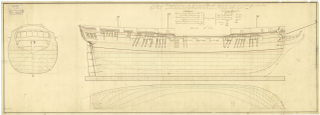
The Thames-class frigate was a 32-gun fifth-rate frigate class of eight ships of the Royal Navy based on the Richmond-class frigate designed by William Bately. The ships were ordered to the older design, which was of a smaller type of ship compared to more modern designs, so that they could be built quickly and cheaply in time to assist in defending against Napoleon's expected invasion of Britain. The class received several design changes to the Richmond class, being built of fir instead of oak, with these changes making the class generally slower and less weatherly than their predecessors, especially when in heavy weather conditions. The first two ships of the class, Pallas and Circe, were ordered on 16 March 1804 with two more ordered on 1 May and the final four on 12 July. The final ship of the class, Medea, was cancelled on 22 October before construction could begin but the other seven ships of the class were commissioned between 1804 and 1806.

HMS Jason was a 36-gun fifth-rate Penelope-class frigate, launched in 1800. She served the entirety of her career in the English Channel, mostly in the frigate squadron of Commodore Charles Cunningham. Serving off the coast of France, especially around Le Havre and Cherbourg, she captured several French privateers and recaptured a British merchant ship in a cutting out expedition. Having only been in commission for around fifteen months, Jason was wrecked off the coast of St Malo on 21 July 1801. Her crew were saved and later exchanged, and in August her wreck was burned to prevent the French from rescuing it.
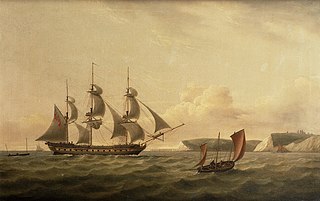
HMS Hussar was a 38-gun fifth-rate Amazon-class frigate of the Royal Navy. Launched at the end of 1799, the entirety of the frigate's career was spent serving in the English Channel and off the coast of Spain. Hussar primarily served as a convoy escort and cruiser, in which occupation the frigate took several prizes, including the French privateer Le General Bessieres. Towards the end of 1803 Hussar was sent to serve in Sir Edward Pellew's Ferrol squadron. On 8 February 1804 Hussar was returning to England with dispatches when the ship was wrecked off the coast of Île de Sein. The crew attempted to sail for home in a fleet of commandeered boats, but the majority were forced to go into Brest to avoid sinking in bad weather, where they were made prisoners of war.

The Perseverance-class frigate was a 36-gun, later 42-gun, 18-pounder fifth-rate frigate class of twelve ships of the Royal Navy, constructed in two batches. Designed by Surveyor of the Navy Sir Edward Hunt the first iteration, consisting of four ships, was constructed as a rival to the similar Flora-class frigate. Strongly built ships, the Perseverance class provided favourable gunnery characteristics and was highly manoeuvrable, but bought these traits with a loss of speed. The name ship of the class, Perseverance, was ordered in 1779 and participated in the American Revolutionary War, but her three sister ships were constructed too late to take part. The class continued in service after the war, but soon became outdated.

HMS Resistance was a 36-gun fifth-rate Aigle-class frigate of the Royal Navy, one of a pair designed by Sir John Henslow. Resistance was commissioned in May 1801 by Captain Henry Digby, and after brief service in the English Channel the frigate left for Quebec in charge of a convoy. While on voyage Resistance captured the French privateer Elizabeth, which was the last ship captured during the French Revolutionary War. Having returned to England at the end of the year, the frigate resumed service in the English Channel, with Captain Philip Wodehouse replacing Digby. On 31 May 1803 Resistance was sailing to the Mediterranean Sea when she was wrecked off Cape St. Vincent; the crew survived.
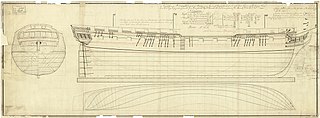
Aigle-class frigates were 36-gun sailing frigates of the fifth rate designed by Surveyor of the Navy, Sir John Henslow for the Royal Navy. Only two were built: HMS Aigle and HMS Resistance. Aigle was ordered first on 15 September 1798 but a 16-month delay during her construction meant that Resistance was completed and launched first on 29 April 1801.
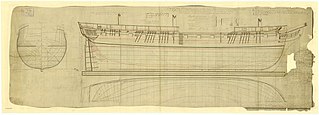
HMS Blanche was a 36-gun fifth-rate Apollo-class frigate of the Royal Navy. She was commissioned in 1800 by Captain Graham Hamond, under whom on 2 April 1801 Blanche fought as part of the frigate reserve at the Battle of Copenhagen. She spent the remainder of the French Revolutionary Wars serving in the English Channel. When the Napoleonic Wars began in 1803 Blanche was sent to serve in the West Indies under the command of Captain Zachary Mudge. There the frigate participated in the Blockade of Saint-Domingue and an unsuccessful invasion of Curacao, capturing upwards of twenty-four vessels.

HMS Trent was a fifth-rate sailing frigate of 36 guns, built for the Royal Navy and launched in February 1796. She carried a main battery of twenty-six 18-pounder (8.2-kilogram) long guns. She and her sister ship HMS Glenmore were constructed from pitch pine rather than oak.


















